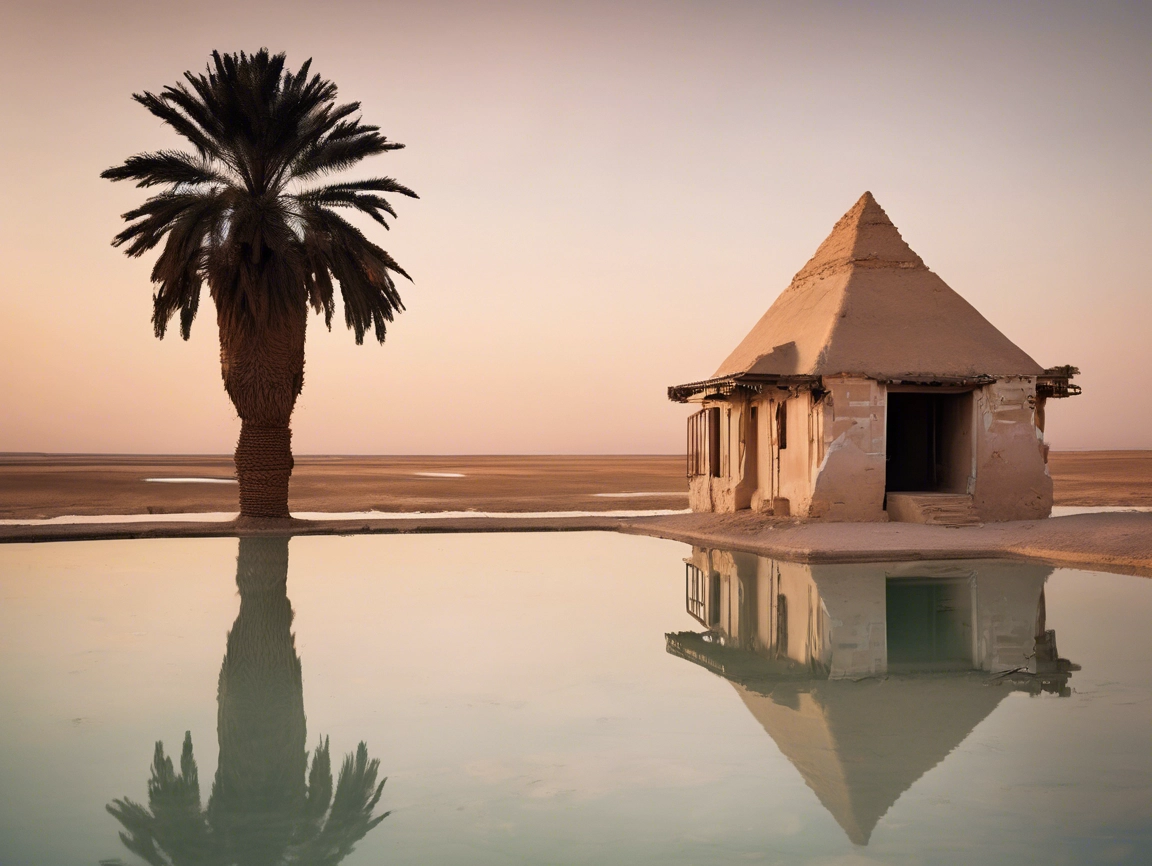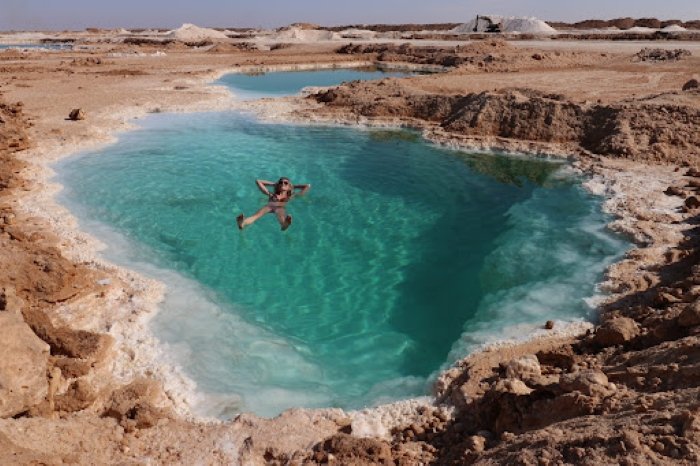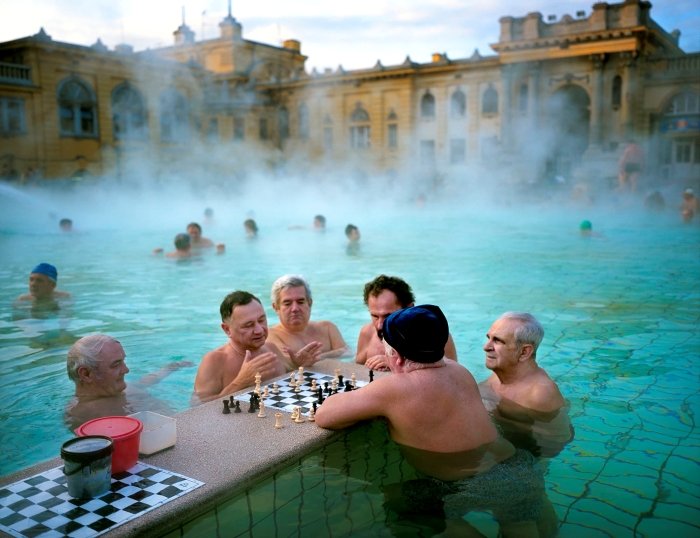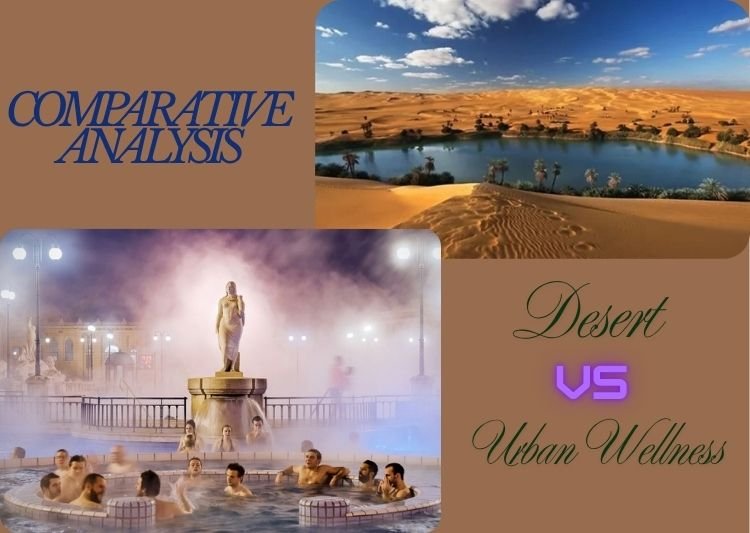Physical Address
304 North Cardinal St.
Dorchester Center, MA 02124

Discover the healing powers of nature's most enchanting waters as we explore two of the world's most captivating wellness destinations: Siwa's mystical salt lakes in Egypt and Budapest's grand thermal baths in Hungary. This comprehensive guide reveals budget-friendly ways to experience these magical springs, from affordable flights and accommodations to hidden gems and local culinary delights. Whether you're seeking a serene family vacation or an adventurous solo getaway, join us on a journey that promises transformative experiences and unforgettable memories in these extraordinary landscapes. Your adventure to wellness awaits!
Magical Springs- A Journey Between Siwa’s Salt Lakes (Egypt) and Budapest’s Thermal Baths (Hungary)

Magical Springs
Discover the healing powers of nature’s most enchanting waters as we explore two of the world’s most captivating wellness destinations. From Egypt’s ancient desert oasis to Hungary’s grand thermal palaces, this comprehensive guide reveals budget-friendly ways to experience these magical springs with cheap flights and budget-friendly hotels.
• Introduction: Two Worlds of Healing Waters • Siwa Oasis: Egypt’s Desert Jewel • Budapest’s Thermal Heritage: Hungary’s Spa Capital • Budget Travel Planning and Cost Comparisons • Cultural Experiences and Local Immersion • Best Times to Visit Both Destinations • Accommodation Options for Every Budget • Transportation and Getting Around • Local Cuisine and Dining Recommendations • Hidden Gems and Off-the-Beaten-Path Experiences • Practical Travel Tips and Visa Information • Frequently Asked Questions • Conclusion and Call to Action
Picture this: you’re floating effortlessly in crystalline waters, your body weightless as mineral-rich springs work their ancient magic on tired muscles and stressed minds. Now imagine experiencing this bliss in two completely different worlds – the mystical desert silence of Egypt’s Siwa Oasis and the grand architectural splendor of Budapest’s legendary thermal baths.
During my travels across continents searching for nature’s most therapeutic waters, I’ve discovered that some of life’s most profound healing experiences don’t require breaking the bank. These two destinations represent the perfect blend of natural wonder and cultural richness, offering transformative experiences for families seeking Family Vacation Ideas and solo adventurers hunting for Undiscovered treasures.

Siwa Oasis
Nestled 560 kilometers west of Cairo, Siwa Oasis emerges from the Sahara like a mirage made real. The moment you first glimpse these ancient salt lakes, you understand why Alexander the Great journeyed here to consult the Oracle of Amun. The landscape feels otherworldly – vast salt flats stretch toward endless dunes while palm groves create pockets of impossible green against the golden desert canvas.
The salt concentration in Siwa’s lakes rivals that of the Dead Sea, creating an almost supernatural buoyancy that leaves first-time visitors laughing with amazement. Local guide Ahmed once told me, “The desert gives back what it takes – it takes your stress and gives you peace.” These words echo in my mind every time I sink into those therapeutic waters.
Smart travelers know that experiencing Siwa’s magic doesn’t require luxury budgets. Local buses from Cairo cost around $15-20, making this one of Egypt’s most accessible unfamiliar places. Budget accommodations like Siwa Paradise Hotel offer comfortable stays for $25-35 per night, while traditional mud-brick lodges provide authentic experiences starting at $20.
The beauty of Siwa lies in its simplicity. Entry to the salt lakes is typically free or costs just a few Egyptian pounds. Pack a picnic lunch from local markets – fresh dates, local cheese, and flatbread cost under $5 for a family meal with a view that money can’t buy.
What transforms Siwa from a simple destination into a Cultural Experiences treasure is its living Berber heritage. The Siwi people have maintained their distinct language and customs for centuries, creating an authentic cultural bubble within modern Egypt.
Local women weave intricate baskets from palm fronds while men tend ancient olive groves – some trees here are over 800 years old. The weekly market buzzes with conversations in Siwi dialect, creating a soundtrack unlike anywhere else in Egypt. These moments of cultural authenticity cost nothing but attention and respect.

Budapest’s Thermal Heritage
Budapest’s relationship with thermal springs spans over 2,000 years, from Roman baths to Ottoman hammams to today’s architectural masterpieces. Walking into Széchenyi Thermal Baths feels like entering a grand palace where healing happens amid Neo-Baroque splendor. The contrast couldn’t be starker with Siwa’s desert simplicity, yet both destinations share that magical quality of transformation through water.
The city sits atop over 100 thermal springs, with temperatures ranging from 24°C to 78°C. Each bath complex tells a different story – Rudas preserves Ottoman authenticity with its octagonal pool crowned by a Turkish dome, while Gellért Bath epitomizes Art Nouveau elegance with its colorful mosaic tiles and stained glass windows.
Many travelers assume Budapest’s famous baths require significant investment, but clever planning reveals affordable options. Day passes to major thermal complexes range from $15-25, while local baths like Lukács offer similar experiences for under $10. Evening tickets often provide 30-50% discounts after 6 PM.
For families seeking Undiscovered Paradises, consider the lesser-known Dandár or Csillaghegyi baths where locals outnumber tourists. These neighborhood gems offer authentic thermal experiences for $8-12 per person, complete with old-school Hungarian bath culture.
Budget accommodations cluster around District VII and VIII, with hostels starting at $12-15 per night and family-run guesthouses offering doubles for $35-45. Many provide thermal bath discount vouchers, effectively reducing your wellness costs.
Budapest’s efficient public transport system makes bath-hopping affordable and easy. A daily travel card costs just $5.50 and covers metro, tram, and bus access to all major thermal destinations. The freedom to explore multiple baths in one day transforms your visit into a comprehensive wellness journey.
Walking between central baths like Rudas and Gellért takes just 15 minutes along the beautiful Danube riverbank – free exercise with million-dollar views. Local trams provide scenic routes to outlying thermal complexes while offering glimpses into everyday Hungarian life.

Desert vs Urban Wellness
Both destinations offer scientifically proven therapeutic benefits, though through different mechanisms. Siwa’s hypersaline lakes provide intense mineral absorption – magnesium, calcium, and bromide penetrate the skin while natural buoyancy relieves joint pressure. The desert’s dry heat enhances the detoxification process, creating a comprehensive wellness experience.
Budapest’s thermal waters deliver a different therapeutic profile. Each spring carries unique mineral compositions – some excel at treating rheumatic conditions while others focus on skin disorders or respiratory issues. The variety allows visitors to customize their healing journey based on specific health needs.
The mental health benefits prove equally compelling in both locations. Siwa’s profound silence and star-filled nights provide digital detox and deep meditation opportunities. Budapest’s architectural beauty and urban energy offer cultural stimulation while thermal soaking reduces stress hormones.
Creating a realistic budget comparison reveals surprising insights:
Siwa Oasis (7 days): • Transportation from Cairo: $20 • Budget accommodation: $140-175 • Meals: $70-105 • Activities and salt lake access: $20-30 • Total: $250-330 per person
Budapest (7 days): • Budget accommodation: $85-135 • Meals: $105-175 • Thermal bath passes: $70-105 • Local transportation: $25-35 • Total: $285-450 per person
Both destinations prove remarkably affordable for extended stays, especially when incorporating money-saving strategies like cooking some meals, choosing local transport, and seeking off-season deals.
Beyond the famous salt lakes, Siwa harbors Local favorites that most tourists never discover. The Fantasy Island area offers multiple salt pools at different concentrations, allowing gradual acclimatization to the intense salinity. Local guide Mahmoud revealed this spot during my third visit – it’s become my personal sanctuary for sunrise meditation.
The Mountain of the Dead (Gebel al-Mawta) provides breathtaking sunset views over the oasis while housing ancient tombs decorated with vivid hieroglyphics. Entry costs just $3, yet the experience rivals Egypt’s most famous archaeological sites. The climb requires moderate fitness but rewards visitors with panoramic views and profound historical connection.
Budapest locals guard certain thermal secrets fiercely. The Lukács Bath’s outdoor pools connect to indoor thermal chambers through underwater passages – discovering these hidden connections feels like uncovering architectural mysteries. Regular visitors develop their own soaking rituals, moving between different temperature pools in specific sequences for maximum therapeutic benefit.
The Rudas Bath’s rooftop thermal pool opens weekend evenings, transforming the Ottoman-era complex into a magical nighttime experience. City lights reflect in the thermal waters while the Danube flows silently below – it’s Budapest’s best-kept romantic secret.
For Nature & Wildlife enthusiasts, the Palatinus Bath on Margaret Island combines thermal therapy with beautiful parkland settings. Peacocks wander the grounds while ancient trees provide natural shade between soaking sessions.
Timing significantly impacts both destinations’ appeal and affordability. Siwa’s ideal season runs from October through April when desert temperatures remain comfortable for extended outdoor activities. Peak months (December-February) see the most pleasant weather but also higher accommodation prices and increased crowds around New Year.
Summer visits to Siwa require serious preparation – temperatures exceed 45°C, making midday salt lake visits challenging. However, summer rates drop dramatically, and the experience of floating in cooling salt water while surrounded by blazing desert creates unforgettable contrasts.
Budapest’s thermal baths shine year-round, but each season offers distinct advantages. Winter thermal bathing provides magical experiences as snow falls around outdoor pools heated to 38°C. Spring and autumn deliver perfect weather for combining thermal therapy with city exploration. Summer brings vibrant outdoor bath culture but higher prices and crowds.
Egypt requires visas for most nationalities, available on arrival for $25 or through e-visa systems for convenience. Budapest, being in the EU, allows visa-free entry for many countries or Schengen visas for others. Always verify current requirements through official government sources as policies change frequently.
Both destinations welcome families, but Egypt requires additional documentation for minors traveling without both parents. Budapest’s EU membership simplifies travel for European families while providing clear regulations for international visitors.
Siwa’s accommodation scene reflects its unique cultural position. Traditional lodge experiences like Adrère Amellal offer luxury desert immersion for $200+ per night, complete with mud-brick architecture and organic gardens. However, budget travelers find excellent alternatives.
Family-run guesthouses provide authentic experiences for $15-25 per night. Owners often speak limited English but communicate through genuine hospitality – sharing meals, arranging desert excursions, and offering insights impossible to find in guidebooks. These connections transform simple accommodation into Cultural Experiences worth remembering.
Camping represents Siwa’s most budget-friendly option. Organized camps near the salt lakes charge $8-12 per person including meals and basic facilities. Sleeping under Siwa’s pristine night sky while listening to desert winds creates memories that five-star hotels can’t match.
Budapest’s accommodation options span every budget and preference. Luxury thermal hotels like Aria or Four Seasons provide direct spa access and premium services for $200-400 per night. Mid-range options include boutique hotels in restored historical buildings for $80-150 per night.
Budget travelers benefit from Budapest’s excellent hostel culture. Clean, safe accommodations start at $12-18 per night in dormitories, while private rooms in hostels cost $35-50. Many hostels organize thermal bath group visits, reducing individual costs while creating social experiences.
Apartment rentals through local platforms often provide better value for families or longer stays. Full apartments with kitchens cost $40-80 per night, allowing significant food budget savings while providing authentic neighborhood experiences.
For Family Trip Planning, Budapest’s apartment hotels offer perfect compromises – hotel services with apartment space and kitchen facilities. These typically cost $60-120 per night for family-suitable units.
Siwa’s isolation created unique culinary traditions blending Berber, Egyptian, and North African influences. Local dates – some varieties exist nowhere else – provide natural sweetness enhanced by desert minerals. The oasis produces exceptional olive oil from ancient groves, creating flavors impossible to replicate elsewhere.
Traditional meals center around simple, fresh ingredients. Fatah bread baked in sand ovens tastes unlike any other flatbread. Local women prepare dishes using traditional methods passed through generations – tagines simmered over palm wood fires, preserves made from desert fruits, and herbal teas blended from wild plants.
Budget eating in Siwa means embracing local rhythms. Market visits reveal fresh produce, local cheeses, and traditional sweets for incredibly low prices. A family can eat well for $10-15 per day by shopping locally and picnicking near the salt lakes.
Budapest’s food scene perfectly complements its thermal culture. Traditional Hungarian dishes like goulash and schnitzel provide hearty comfort after long soaking sessions. Thermal bath cafeterias serve budget-friendly meals, typically $5-8 for substantial portions.
The city’s market halls, especially the Great Market Hall, offer authentic local products at reasonable prices. Fresh langos (fried flatbread) costs under $3 and provides perfect post-bath snacking. Local wines, particularly from nearby regions, complement thermal relaxation beautifully.
Restaurant diversity means every budget finds satisfaction. Traditional csárdá restaurants serve authentic Hungarian cuisine for $12-20 per person, while trendy ruin bars provide atmospheric dining with moderate prices. Street food scenes around major baths offer quick, affordable options.
For Planning Travel Trips that include culinary exploration, Budapest’s food tours often incorporate thermal bath visits, creating comprehensive cultural experiences.
Reaching Siwa requires planning but rewards patience with authentic desert travel experiences. Most visitors fly into Cairo then choose between buses, private transport, or organized tours. Budget bus services like West Delta Travel provide comfortable transport for $15-20, with the journey taking 8-10 hours through changing landscapes.
Private car hire costs $80-120 for the round trip but allows flexibility for desert stops and photography. Shared taxis offer middle-ground options at $30-40 per person. The journey itself becomes part of the adventure – watching Cairo’s urban sprawl give way to agricultural lands, then gradually transform into endless desert vistas.
Within Siwa, bicycles provide perfect transportation for exploring the compact oasis. Rental costs just $3-5 per day, and cycling between palm groves, salt lakes, and archaeological sites creates intimate connections with the landscape impossible from vehicles.
Budapest’s integrated transport system makes thermal bath exploration effortless. The metro system connects major bath complexes efficiently, while trams provide scenic routes along the Danube. Day passes at $5.50 offer unlimited travel, making spontaneous bath-hopping affordable.
Walking distances between central thermal baths rarely exceed 20-30 minutes, often through beautiful neighborhoods worth exploring. The Chain Bridge walk between Buda and Pest sides provides stunning city views while connecting different thermal districts.
For visitors planning extensive thermal exploration, weekly transport passes cost $16 and include access to suburban areas with additional lesser-known thermal facilities. This transforms Budapest into an affordable wellness playground.
Understanding Siwa’s desert climate optimizes both comfort and budgets. Peak season (November-March) brings perfect temperatures but higher costs and crowds. Shoulder seasons (October, April) offer excellent weather with reduced prices and authentic local interactions.
Summer visits require different strategies but provide unique advantages. Morning salt lake sessions before sunrise avoid extreme heat while creating magical photography opportunities. Midday siestas align with local rhythms, while evening activities extend well into comfortable night hours.
Desert weather can change rapidly – pack layers even during warm seasons. Sand storms occasionally occur but typically last just hours. Local weather wisdom proves more reliable than international forecasts, so building relationships with guides and hosts provides valuable insights.
Budapest’s thermal baths adapt beautifully to seasonal changes. Winter thermal bathing creates almost magical experiences – steam rising from 38°C pools while snow falls creates scenes from fairy tales. Indoor thermal halls provide warm retreats, while brave souls enjoy the thrill of moving between hot pools and cold winter air.
Spring brings ideal conditions for combining thermal relaxation with city exploration. Parks bloom around thermal complexes while comfortable temperatures allow extended outdoor soaking. This season often provides the best balance of weather, prices, and crowd levels.
Summer transforms Budapest’s outdoor thermal culture. Night bathing under stars becomes popular, while rooftop pools extend operating hours. However, popular baths become crowded, and prices peak during European holiday seasons.
Autumn offers perfect thermal weather with fewer crowds and moderate prices. The city’s thermal gardens showcase beautiful fall colors while providing comfortable outdoor soaking conditions.
Siwa’s salt lakes provide therapeutic benefits documented by both ancient wisdom and modern science. The high mineral content – particularly magnesium, calcium, and bromide – penetrates skin barriers during extended soaking. These minerals reduce inflammation, improve circulation, and promote muscle relaxation.
The unique composition of Siwa’s salt differs from standard sea salt or even Dead Sea salt. Local minerals created through centuries of desert evaporation provide distinct therapeutic profiles. Dermatological studies show improvements in skin conditions like eczema and psoriasis after regular exposure to these specific mineral combinations.
Buoyancy effects in hypersaline water reduce joint stress while allowing gentle movement impossible on land. This makes Siwa’s lakes particularly beneficial for arthritis sufferers or injury recovery. The weightless sensation also provides psychological benefits – stress reduction and mental clarity often reported by visitors.
Budapest’s thermal waters offer different but equally impressive therapeutic benefits. Each spring carries unique mineral profiles targeting specific health conditions. Széchenyi’s waters excel at treating locomotive disorders, while Rudas focuses on circulatory issues.
The variety of temperatures available – from cooling 24°C pools to therapeutic 40°C+ waters – allows progressive thermal therapy. This gradual temperature adjustment improves circulation more effectively than single-temperature experiences. Medical professionals in Budapest often prescribe specific thermal protocols for various conditions.
Thermal therapy combined with architectural beauty provides additional psychological benefits. The grandeur of Budapest’s bath houses creates positive mental associations with healing, potentially enhancing therapeutic outcomes through improved mindset and reduced stress.
Research indicates that regular thermal bathing improves sleep quality, reduces anxiety, and boosts immune function. These benefits accumulate over time, making extended stays or return visits increasingly beneficial.
Siwa’s conservative Berber culture requires respectful visitor behavior. Traditional dress codes apply, especially around inhabited areas. Women should cover shoulders and legs, while men should avoid shorts in town centers. However, swimming attire is acceptable at salt lakes away from residential areas.
Photography etiquette proves particularly important. Always ask permission before photographing people, and respect refusals gracefully. Many local women prefer not to be photographed, while men often welcome respectful requests. Children enjoy having their photos taken but appreciate seeing results on camera screens.
Friday prayers create quiet periods when tourist activities should minimize. This provides perfect opportunities for personal reflection or salt lake meditation. Respecting these spiritual rhythms creates positive relationships with local communities.
Language barriers dissolve through patience and humor. Learning basic Arabic greetings like “ahlan wa sahlan” (welcome) and “shukran” (thank you) creates immediate positive connections. Local people appreciate efforts to communicate in Arabic even when English is available.
Budapest’s thermal baths maintain specific cultural protocols developed over centuries. Understanding these customs enhances experiences while showing respect for local traditions. Nudity requirements vary by bath and section – research specific locations before visiting to avoid embarrassment.
Thermal bath etiquette includes showering before entering pools, not wearing street clothes in water areas, and maintaining quiet conversation levels. Many locals use thermal baths for meditation and relaxation, so respecting peaceful atmospheres proves important.
Tipping culture in thermal facilities follows Hungarian standards – small amounts for attendants providing towels or lockers, slightly more for massage services. However, tipping isn’t mandatory, and friendly acknowledgment often suffices.
Some baths maintain gender-separated sections or days. Rudas, for example, offers men’s and women’s specific times for traditional Turkish bath experiences. These traditions preserve historical authenticity while providing comfortable experiences for all visitors.
Siwa’s photographic opportunities span from intimate cultural moments to vast landscape panoramas. Salt lake photography requires specific techniques – polarizing filters reduce glare while enhancing color contrast between desert and oasis. Golden hour lighting (first and last hour of sunlight) transforms ordinary scenes into extraordinary images.
Respect for local photography preferences creates better relationships and often leads to more authentic image opportunities. Many residents welcome respectful photography requests, sometimes offering to pose in traditional clothing or demonstrate traditional crafts.
Desert photography challenges include sand protection for equipment and extreme lighting conditions. Simple precautions like keeping cameras in sealed bags between shots and using lens hoods prevent most technical problems. The reward – images impossible to capture anywhere else – justifies the extra care.
Night photography in Siwa reveals incredibly clear skies perfect for star photography. Light pollution virtually doesn’t exist, creating opportunities for spectacular astrophotography. Combining salt lake reflections with star fields produces truly unique images.
Budapest’s thermal baths provide stunning architectural photography opportunities. However, many facilities restrict photography inside bath areas for privacy reasons. Always check policies before bringing cameras into changing areas or pool sections.
External architectural photography faces no restrictions and offers incredible opportunities. The blend of Neo-Baroque, Art Nouveau, and Ottoman architectural styles creates visually compelling compositions. Different lighting conditions throughout the day highlight various architectural details.
Seasonal photography in Budapest provides dramatically different moods. Winter steam effects around outdoor thermal pools create ethereal imagery, while summer’s lush gardens provide colorful contrasts to classical architecture.
Evening and night photography around illuminated thermal complexes produces romantic, atmospheric images. The reflection of architectural lighting in thermal pools creates magical photographic opportunities impossible during daylight hours.
Siwa’s desert ecosystem faces increasing pressure from tourism and climate change. Responsible visitors minimize environmental impact through conscious choices. Staying in locally-owned accommodations supports community economies while reducing resource consumption compared to large hotels.
Water conservation proves particularly important in desert environments. Siwa’s springs provide limited freshwater, so mindful usage helps preserve this precious resource for future generations. Simple actions like shorter showers and reusing towels significantly impact water consumption.
Waste management in remote desert locations requires personal responsibility. Carrying reusable water bottles, avoiding single-use plastics, and packing out all trash helps preserve Siwa’s pristine environment. Local communities lack advanced waste processing facilities, making visitor responsibility crucial.
Supporting local guides and businesses ensures tourism benefits reach community members while providing authentic cultural exchanges. These economic relationships create incentives for environmental preservation while offering visitors genuine insights into local life.
Budapest’s thermal baths implement various sustainability initiatives, from energy-efficient heating systems to water recycling programs. Visitors support these efforts by choosing environmentally conscious facilities and behaviors.
Public transportation use instead of taxis or rental cars significantly reduces individual carbon footprints while providing authentic local experiences. Budapest’s excellent public transport system makes sustainable travel convenient and affordable.
Choosing local restaurants and markets over international chains supports community economies while often providing fresher, more authentic food experiences. Local sourcing also reduces transportation environmental impacts while connecting visitors to regional culinary traditions.
Water conservation remains important even in thermal-rich Budapest. These precious thermal resources require protection through conscious consumption and respect for facility guidelines designed to preserve water quality and availability.
Siwa’s remote location creates connectivity challenges that many visitors find refreshing. Limited internet access encourages digital detox while promoting deeper engagement with natural surroundings and local culture. However, basic connectivity exists for essential communications.
Most accommodations offer Wi-Fi, though speeds and reliability vary significantly. Mobile phone coverage from major Egyptian carriers reaches Siwa town but may be limited in remote salt lake areas. International roaming costs can be high, so purchasing local SIM cards provides affordable communication options.
The connectivity limitations become advantages for travelers seeking authentic experiences away from digital distractions. This natural digital detox often enhances the therapeutic benefits of salt lake relaxation and desert meditation.
For travelers requiring constant connectivity, satellite communication devices provide backup options, though costs may be prohibitive for casual use. Most visitors find that embracing Siwa’s disconnected nature enhances rather than limits their travel experiences.
Budapest offers excellent connectivity throughout the city, including major thermal bath complexes. Free Wi-Fi availability in most accommodations, restaurants, and many public areas ensures easy communication and navigation.
Mobile coverage throughout Budapest remains strong, with major international carriers providing good service. EU residents benefit from eliminated roaming charges, while international visitors find reasonable local SIM card options.
Many thermal baths now offer waterproof phone cases or secure storage options, allowing visitors to capture and share experiences while protecting devices from thermal environment conditions.
Transportation apps, thermal bath reservation systems, and local discovery platforms work reliably throughout Budapest, enhancing visitor experiences while providing real-time information about thermal facility availability and pricing.
Egypt’s favorable exchange rates create excellent value for many international currencies, but smart planning maximizes purchasing power. Booking accommodations directly with local operators often provides better rates than international platforms while supporting community economies.
Group travel significantly reduces per-person costs for transportation, guides, and some accommodations. Families or friend groups can negotiate better rates for private transport and guided experiences while creating shared memories.
Eating local foods from markets and simple restaurants provides authentic experiences at fraction of tourist restaurant costs. A traditional Egyptian breakfast at local cafes costs $2-3 compared to $8-12 at tourist-oriented establishments.
Seasonal timing dramatically affects costs. Visiting during shoulder seasons (October, April) provides excellent weather with reduced accommodation and transportation prices. Flexibility with travel dates can reduce costs by 30-50%.
Budapest’s competitive tourism market creates opportunities for savvy budget travelers. Advance booking for thermal bath passes often provides 20-30% discounts, while combination tickets including multiple attractions offer additional savings.
Accommodation booking timing significantly impacts costs. Mid-week stays cost less than weekends, while booking 2-3 weeks ahead often provides better rates than last-minute reservations or far-advance bookings.
Local eating and drinking habits provide budget insights. Lunch specials at traditional restaurants offer substantial meals for $8-12, while evening dining costs double. Happy hour timing at thermal bath cafeterias provides quality food at reduced prices.
Public transport day passes eliminate per-trip costs while encouraging exploration of different thermal districts. Weekly passes provide even better value for extended stays while including access to suburban thermal facilities.
Desert travel requires specific health preparations, particularly for visitors with medical conditions. Extreme temperature variations between day and night can affect medications and medical devices. Consulting healthcare providers before travel ensures proper preparation.
Dehydration risks increase significantly in desert environments, even during cooler months. Salt lake floating paradoxically increases dehydration risk through enhanced mineral absorption and thermal effects. Maintaining high water intake becomes crucial for health and comfort.
Sun protection requires more attention in desert environments where reflection from salt surfaces increases UV exposure. High SPF sunscreen, protective clothing, and limiting midday exposure prevent serious sunburn that could ruin thermal experiences.
Pre-existing skin conditions may react differently to high-salt environments. While many conditions improve, others might experience temporary irritation. Patch testing on small skin areas before full immersion helps identify potential sensitivities.
Thermal bathing provides therapeutic benefits but requires awareness of medical contraindications. High temperatures can affect blood pressure, heart conditions, and certain medications. Consulting healthcare providers ensures safe thermal experiences.
Pregnancy considerations for thermal bathing vary by trimester and individual circumstances. Many thermal facilities post guidelines for pregnant visitors, but personal medical advice provides the safest guidance for thermal therapy during pregnancy.
Thermal water quality in Budapest meets strict European health standards, but visitors with compromised immune systems should verify current water testing results. Most facilities provide water quality information upon request.
Alternating between hot thermal waters and cool air can stress cardiovascular systems. Gradual temperature transitions and listening to body responses prevents overexertion while maximizing therapeutic benefits.
Beyond the famous Cleopatra’s Pool, Siwa harbors numerous undiscovered thermal springs scattered throughout the oasis. Local guides reveal private springs accessible only through palm grove paths, offering intimate thermal experiences away from any crowds.
The Bir Wahed hot spring, located 12 kilometers from town, provides natural thermal bathing surrounded by pristine desert landscapes. This undevelopped location requires local transport but offers authentic thermal experiences combined with stunning sunset views over the Great Sand Sea.
Alexander’s Tomb site, while archaeologically uncertain, provides incredible views over the entire oasis from the Gebel al-Mawta hillside. The climb takes 30 minutes but rewards visitors with panoramic perspectives impossible from ground level.
Siwa’s traditional crafts workshops, hidden within residential areas, offer authentic cultural encounters. Women demonstrate traditional embroidery while men work silver jewelry using techniques unchanged for generations. These experiences require local connections but provide deep cultural insights.
Budapest’s thermal underground includes lesser-known springs accessible through local knowledge. The Lukács Bath’s writer’s corner, where literary figures gathered for decades, maintains traditional intellectual atmosphere often missed by casual visitors.
Secret thermal pools exist within private clubs and historical buildings throughout Budapest. Some hotels allow day access to exclusive thermal facilities for reasonable fees, providing luxury experiences without accommodation costs.
The Csillaghegyi Thermal Bath, technically within Budapest but feeling suburban, provides authentic local thermal culture. This facility sees few tourists but offers genuine Hungarian bath house experiences with friendly local interactions.
Medicinal thermal springs in Budapest’s parks, while not suitable for bathing, provide interesting historical context. Margaret Island’s ancient Roman spring ruins tell stories of thermal culture spanning millennia.
Multi-destination thermal travel requires specific packing considerations. Swimwear suitable for both conservative desert communities and European thermal facilities avoids cultural issues while maintaining comfort. Quick-dry materials prove essential for frequent thermal activity.
Sun protection items including hats, sunglasses, and high-SPF sunscreen remain crucial for both destinations. Desert conditions obviously require protection, but thermal facility outdoor areas in Budapest also increase sun exposure through reflection and extended outdoor time.
Comfortable walking shoes suitable for both desert terrain and urban exploration serve dual purposes. Sandals appropriate for thermal facility use should dry quickly and provide adequate support for walking on various surfaces.
Personal care items including moisturizers become particularly important due to mineral-rich water exposure and varying climate conditions. Bringing familiar products ensures comfort while allowing exploration of local alternatives.
The most meaningful thermal travel experiences come from embracing each destination’s unique character rather than seeking similarities. Siwa’s desert silence offers profound meditation opportunities, while Budapest’s architectural grandeur provides cultural stimulation alongside thermal relaxation.
Building relationships with local people transforms simple tourism into cultural exchange. Learning basic language phrases, showing interest in local customs, and approaching encounters with curiosity and respect creates lasting connections that enrich travel memories.
Photography and journaling help capture not just visual memories but emotional responses to unique environments. The contrast between floating in silent desert salt lakes and soaking in grand urban thermal palaces creates powerful personal narratives worth preserving.
Flexibility in planning allows spontaneous discoveries that often become trip highlights. Leaving space for unplanned exploration enables responses to local recommendations and personal interests that emerge during travel.
Q: How do the therapeutic benefits of Siwa’s salt lakes compare to Budapest’s thermal springs? A: Both offer proven therapeutic benefits but through different mechanisms. Siwa’s hypersaline waters provide intense mineral absorption and buoyancy effects excellent for joint conditions and skin disorders. Budapest’s varied thermal springs target specific health issues through different mineral compositions and temperatures. The choice depends on individual health needs and preference for desert versus urban wellness environments.
Q: What’s the realistic budget difference between visiting both destinations? A: A week-long visit to Siwa typically costs $250-330 per person including accommodation, meals, and activities. Budapest ranges from $285-450 for similar duration and quality. However, Budapest offers more luxury options that can increase costs significantly, while Siwa’s luxury experiences remain relatively modest by international standards.
Q: Can families with children safely enjoy both destinations? A: Yes, both destinations welcome families, though considerations differ. Siwa requires attention to heat exposure, sun protection, and cultural sensitivity regarding dress codes. Budapest’s thermal baths have specific children’s areas and family-friendly facilities. Both destinations offer educational and fun experiences for children with proper planning.
Q: What’s the best time of year to visit both destinations? A: For visiting both in one trip, spring (March-May) or autumn (September-November) provide optimal conditions. These seasons offer comfortable temperatures in Siwa while maintaining Budapest’s excellent thermal weather. Winter combinations work well for those seeking dramatic contrasts between desert warmth and thermal comfort against cold European weather.
Q: How do visa requirements and travel logistics work for visiting both countries? A: Egypt requires visas for most nationalities (available on arrival or online), while Hungary follows EU visa policies. Planning adequate time between destinations allows for travel fatigue recovery and cultural adjustment. Most visitors find 3-4 days minimum in each location necessary for authentic experiences.
Q: Are there direct flights between Cairo and Budapest to make the journey easier? A: Direct flights exist seasonally but aren’t always available. Most routing goes through European hubs like Frankfurt or Vienna, often making total travel time 6-8 hours including connections. This routing sometimes allows exploration of connection cities for minimal additional cost.
Standing at the crossroads between these two magnificent thermal destinations, you face a choice that extends far beyond simple vacation planning. These magical springs represent two different philosophies of wellness – Siwa’s profound desert silence that strips away modern distractions, and Budapest’s grand architectural embrace that elevates thermal therapy into cultural art.
My own journey between these worlds taught me that healing doesn’t follow a single path. Sometimes you need the vast emptiness of the Sahara to hear your own thoughts clearly. Other times, the elegant grandeur of Hungarian thermal palaces provides the perfect backdrop for restoration and renewal. Both destinations offer transformative experiences accessible to travelers with modest budgets and adventurous spirits.
The beauty of these Local favorites lies not just in their therapeutic waters, but in their ability to shift perspectives and create lasting memories. Whether you’re planning Family Vacation Ideas or seeking personal rejuvenation, both Siwa and Budapest provide authentic experiences that satisfy the soul while respecting the wallet.
For those seeking Honeymoon Getaways, imagine floating together in Siwa’s silent salt lakes under star-filled desert skies, then sharing intimate moments in Budapest’s romantic thermal pools as city lights dance on the water. These contrasting experiences create honeymoon memories spanning different worlds and cultures.
Adventure seekers will find that both destinations challenge preconceptions about wellness tourism. Siwa proves that luxury doesn’t require five-star amenities – sometimes the greatest luxury is perfect silence broken only by gentle desert winds. Budapest demonstrates that historical grandeur and modern comfort can coexist beautifully, creating thermal experiences that honor the past while serving contemporary needs.
Planning your thermal springs adventure begins with understanding your personal wellness goals and travel preferences. Those seeking profound quiet and cultural immersion should prioritize Siwa, while travelers who enjoy urban exploration alongside thermal therapy will find Budapest irresistible. Smart travelers often discover that visiting both creates the perfect balance of contrasting experiences.
Budget planning requires honesty about your travel style and priorities. Both destinations reward visitors who embrace local customs and seek authentic experiences over tourist packaging. The money saved through local eating, simple accommodations, and public transport can be redirected toward extending stays or exploring additional thermal facilities.
Remember that the true value of these destinations extends beyond immediate thermal experiences. The cultural insights gained from Berber traditions in Siwa and Hungarian thermal customs in Budapest provide lasting personal enrichment. These encounters change how you view wellness, travel, and cultural diversity.
For comprehensive Planning Tourist Routes that incorporate thermal destinations, consider the broader regional opportunities. Egypt offers Red Sea diving and Nile cruises within reach of Siwa, while Budapest provides easy access to Central European capitals and additional thermal destinations throughout Hungary.
The journey from inspiration to experience requires decisive action. Start by researching cheap flights and budget-friendly hotels for your preferred travel dates. Both destinations offer excellent value, but advance planning unlocks the best deals and ensures availability during peak seasons.
Connect with local guides and accommodation providers who understand budget travel needs. These relationships often provide insights and opportunities unavailable through standard booking platforms. Personal connections also enhance cultural experiences while supporting local communities.
Consider extending your stay in either or both destinations. The therapeutic benefits of mineral-rich waters accumulate over time, while longer visits allow deeper cultural immersion and more authentic local interactions. Many visitors find that what they initially planned as short stops become transformative extended experiences.
Document your journey through photography, journaling, or social media sharing that inspires others to discover these incredible destinations. Your experiences might encourage friends and family to explore thermal tourism, creating shared interests and potential future travel companions.
As someone who has experienced the transformative power of both destinations, I invite you to take that first step toward your own thermal adventure. Whether you choose Siwa’s mystical desert springs, Budapest’s architectural thermal grandeur, or the incredible contrast of experiencing both, you’re embarking on a journey that will change how you understand wellness and travel.
These magical springs have been healing bodies and souls for centuries. The Berber people of Siwa and the thermal culture enthusiasts of Budapest maintain traditions that honor water’s healing power while welcoming respectful visitors to share in these ancient practices.
Your adventure awaits – from the silence of Egypt’s desert oasis to the grandeur of Hungary’s thermal capital. The question isn’t whether these destinations will affect you profoundly, but how you’ll integrate their lessons into your ongoing life journey.
Ready to discover your own magical springs experience? Visit Travel Go Easy to start planning your thermal adventure today. Our platform connects you with budget-friendly accommodations, affordable transportation options, and local experiences that transform simple trips into lifelong memories.
Explore more incredible destinations and hidden gems on our website, where every journey begins with a single click toward adventure.
Connect with local guides and accommodation providers who understand budget travel needs. These relationships often provide insights and opportunities unavailable through standard booking platforms. Personal connections also enhance cultural experiences while supporting local communities.





[…] Get Started Now […]